Patents
Comforting Hand Pillow
Madeline Robertson was recently granted a patent for a pillow with a foam hand sewn onto it. She explains that the hand (or 'tactile object,' as she refers to it) "provides tactile sensory feedback to the user designed to comfort the user."It reminds me of that robotic hand for people who have no one to hold their hand on walks we recently posted about.
Patent No. 10806281: Substrate having a therapeutic tactile object attached
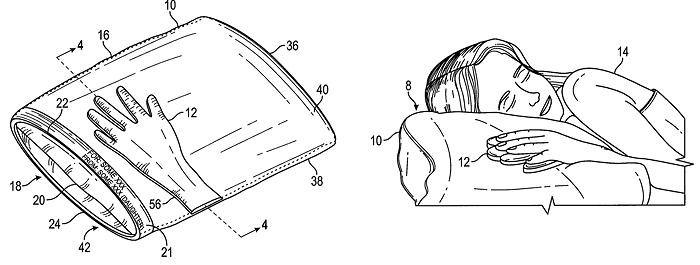
Posted By: Alex - Mon Nov 30, 2020 -
Comments (0)
Category: Inventions, Patents, Sleep and Dreams
The feather paintings of Ida Jarvis
Ida Helen Jarvis came up with the idea of making pictures out of feathers. She would travel around the world, visiting zoos and aviaries to add to her feather collection. Then she would arrange the feathers to form pictures of landscapes, gluing or stitching the feathers onto a cardboard mat.She was so taken with this idea that she decided to patent it (Patent No. 1,395,575, 1921). Included in her patent was the idea of using down to represent foam in a stream of water.
Her feather paintings must have been quite colorful. But unfortunately the only image of one I can find is the black-and-white drawing included with her patent.
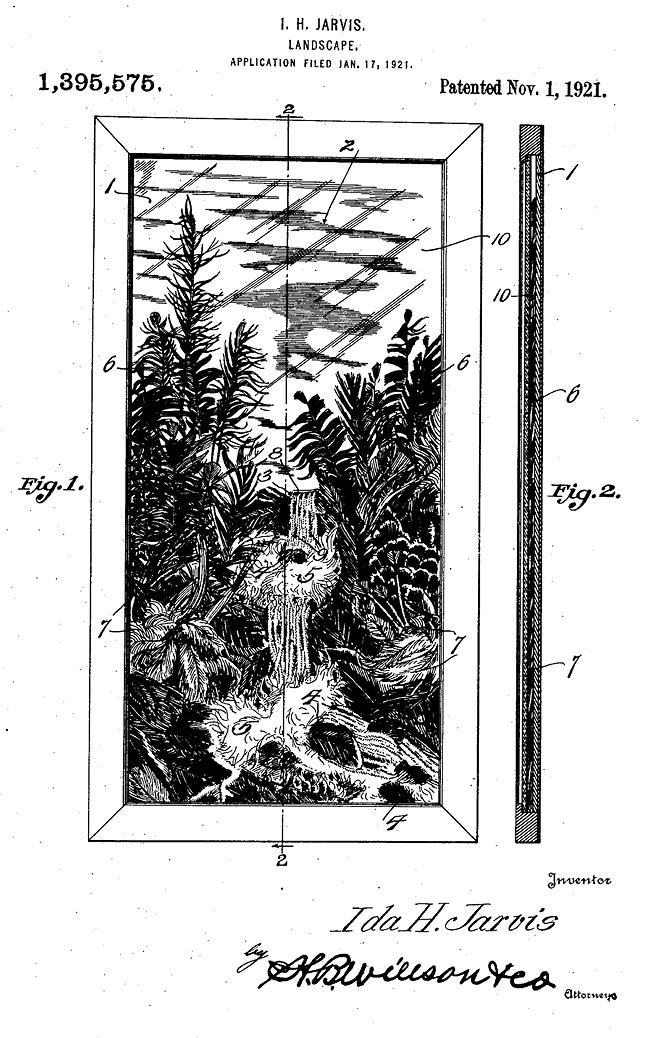
Posted By: Alex - Sun Nov 22, 2020 -
Comments (3)
Category: Art, Inventions, Patents, 1920s
Beauty Pillow
Patent No. 2,533,526 was granted to Yvonne Bersia Snyder of Forest Hills, NY for a "Beauty Pillow":During sleep the tissues of the face are usually crushed or folded in the same position for hours at a time. For example, the flesh of the cheeks or face when flattened against the pillow during the sleeping hours pushes the skin forwards and settles in the hollows of the eyes where it produces wrinkles.
It is an object of this invention to prevent wrinkles or damaging of the skin tissues during rest.
Looks like it could also double as headgear for full-contact sports.

Posted By: Alex - Sun Nov 15, 2020 -
Comments (3)
Category: Beauty, Ugliness and Other Aesthetic Issues, Inventions, Patents, Sleep and Dreams, 1950s
Landslide—the electoral college board game
Kenneth J. Gross and Sebron Koster were granted a patent in 1960 for Landslide, an electoral college board game. Players moved their pieces around the board trying to gain enough electoral college votes to start a 'landslide'. If you want to play it, the rules are below.As far as I can tell, their game was never sold in stores. However, there have been two other board games called Landslide that did make it to market (in 1971 and 2004). Both involved acquiring electoral college votes but were otherwise different than the 1960 version.
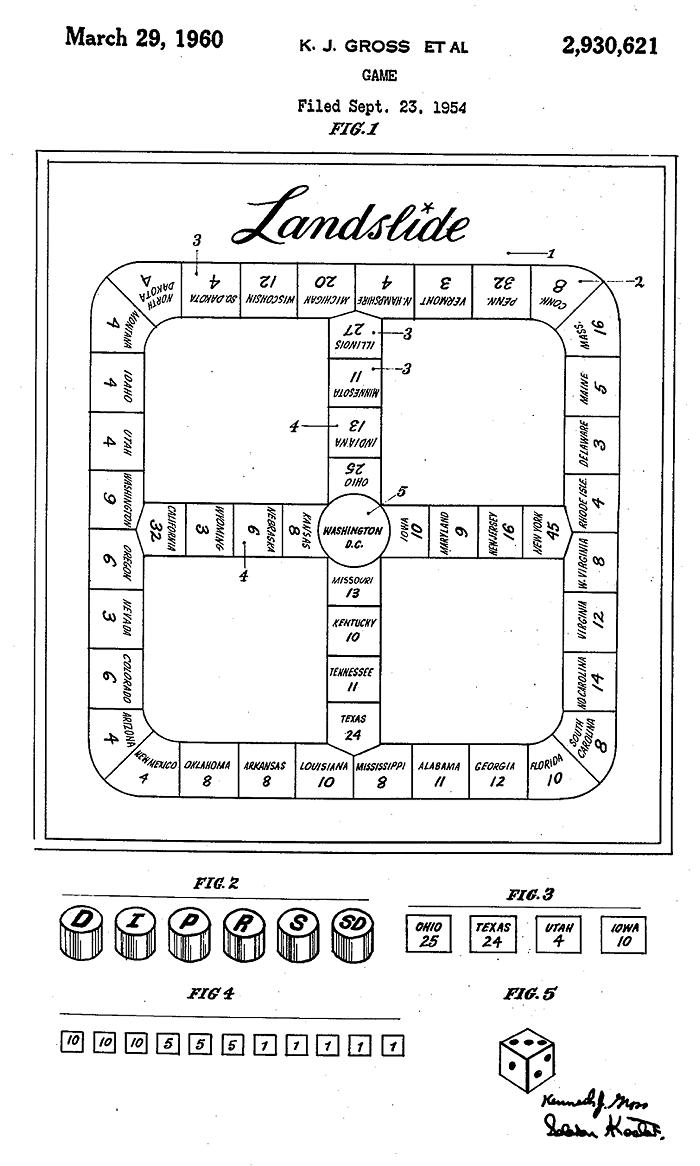
At the start of the play of a game each player selects his political party and takes his marker and tokens to match. Each player or candidate rolls the die and the candidate who rolls high die opens the play. He is succeeded in turn by each candidate in a clockwise direction. All candidates begin their campaign from the central segment, viz. Washington, D.C.
The number appearing on the die indicates the number of segments (States) which the candidate may move his marker and the number of electoral votes he wins in the State attained. He places his marker on that State and beside it his tokens corresponding to the number of votes thereby won in that State.
On each turn a candidate may move in any direction he chooses. The choice of routes allowed to candidates enables them to exert an influence on the development of their campaigns. In passing through a junction of three States he may traverse only two of the States in the course of any one move. He may not reverse his direction of movement in the course of one move. A candidate may not land on nor pass through a State occupied by another candidate's marker. If the movement of a candidate is blocked by the markers of other candidates in such a manner that he cannot move his marker to the full extent of his throw of the die, then he loses that turn. A candidate must move if possible.
A candidate must return to Washington, D.C. at any time that his throw of the die could place him there, providing that Washington, D.C. is unoccupied.
The number of electoral votes of a State won by a candidate is indicated by his tokens placed alongside that State. The entire electoral vote of a State is won by the first candidate to obtain a majority of the electoral votes of that State. When a State is won by a candidate he removes the card of that State and all the electoral vote tokens on that State are returned to their respective candidates.
States that have not been won are indicated by the presence of the State cards still beside them. Any candidate may land on a State that has been won by another candidate irrespective of the presence or absence of electoral votes remaining unacquired.
Whenever a candidate lands on Washington, D.C., he has the right to call a “caucus' if he so desires. When a caucus is declared all candidates count, the electoral votes of the States they have won completely, as indicated by the State cards in their possession. The outstanding electoral votes relating to States not yet won are also counted. Should the candidate with the least number of electoral votes be unable to win the election even by winning all the electoral votes of the States which are not yet won completely then he is eliminated as a presidential candidate. Only one candidate may be eliminated on each caucus.
If on the calling of a caucus, the tally of electoral votes indicates that every candidate still has a chance to win the election assuming his acquisition of all outstanding electoral votes, then the candidate calling the caucus loses all his electoral votes on States not won completely; that is he removes all his electoral vote tokens from the board.
The electoral vote tokens of the eliminated presidential candidate on the States not completely won are removed from the board. The electoral votes of the States completely won by the eliminated candidate are divided among the remaining candidates according to the geographical distribution set out in the table above. In other words the candidate with the most electoral votes from the Eastern States, takes all the Eastern States from the eliminated candidate and similarly for the other geographical groups of States.
The presidential election is won by the first candidate who captures 266 or more electoral votes.
Posted By: Alex - Sun Nov 01, 2020 -
Comments (1)
Category: Games, Politics, Patents, 1960s
Glue-On Sweat Diverter
Rosecroft Components recently (Dec 2019) was granted a patent for a glue-on "sweat diverter". From their patent:Described herein are sweat-diverting devices which may be affixed to a wearer by an adhesive, such as a pressure-sensitive adhesive...
A sweat-diverting device may be reusable, with an adhesive reapplied for each wearing, or may be single use and disposable, with the adhesive integrated with the device during manufacturing.




Posted By: Alex - Sun Oct 25, 2020 -
Comments (1)
Category: Fashion, Headgear, Inventions, Patents, Body Fluids
Wrinkle Mask
Adelaide Smith was granted a patent for this "wrinkle mask" in 1911. It has a certain Bride of Frankenstein look to it.
My invention dispenses with the usual work in massaging, employed for removing the wrinkles or blemishes from the face, and can be used at any time more particularly, however, at nights while the patient is sleeping.
Posted By: Alex - Sun Oct 18, 2020 -
Comments (3)
Category: Beauty, Ugliness and Other Aesthetic Issues, Inventions, Patents, 1910s
Carl Bohland’s Auto Wash Bowl
Carl Bohland patented the auto wash bowl in 1921. His idea was that cars would drive into a large, concrete bowl filled with water. After a couple of times around the bowl, the cars would be clean. Or, at least, cleaner.

Bohland managed to open a few auto wash bowls. The problem, however, was that his technique only really cleaned the underside of the cars. This was useful back in the days when many roads were still unpaved and their undersides constantly got filthy. But as road conditions improved, the auto wash bowl became less useful. By the 1930s, the last one had closed.
More info: vintag.es
Posted By: Alex - Sun Oct 11, 2020 -
Comments (5)
Category: Inventions, Patents, 1920s, Cars
Disease detection toilet using dog
Patent #10,455,817 was granted in Oct 2019 for "animal olfactory detection of disease as control for health metrics collected by medical toilet."In plainer language, it's a toilet that has a small door built into the side of it (the "scent dispenser"), allowing a dog to smell your poop (or other bodily fluids) in order to detect the presence of disease. From the patent:
An animal may be trained to sniff the scent dispenser in response to a command or signal. The user may give the animal the command or signal when the user desires the animal to assess the presence of disease in the user.

Posted By: Alex - Sun Oct 04, 2020 -
Comments (2)
Category: Bathrooms, Inventions, Patents, Dogs
Health Jolting Chair
Oliver Halsted was granted a patent for an "exercising machine" in 1844. It was later marketed as the Health Jolting Chair. AKA the "wake-up chair." By pulling the levers on the side, it would bounce up and down. It was said to be a panacea for "dyspepsia, liver complaint, low spirits, general debility, constipation, 'so-called malaria,' jaundice, melancholia, and anemia."
Image source: Natl Lib of Medicine
Posted By: Alex - Sun Sep 27, 2020 -
Comments (0)
Category: Exercise and Fitness, Health, Inventions, Patents, Nineteenth Century
Subjective Color
July 25, 1967: During its broadcast of the TV series Combat!, ABC aired a commercial for a soft-drink called Squirt. The commercial appeared in color. What made this unusual is that it appeared in color even on black-and-white TV sets.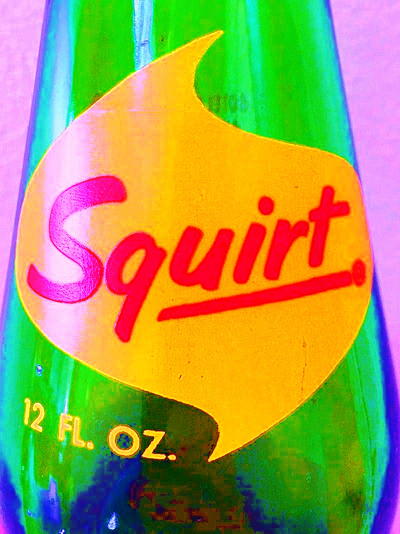
The commercial used a technology developed by the Color-Tel Corp., and patented by James Butterfield, that used pulses of light to trick the brain into thinking that it was seeing color. Butterfield described this as "subjective color".
The company had informed the media before the broadcast, but most people didn't know it was going to happen, and so they thought they were going nuts when they suddenly saw flashes of color on their black-and-white sets.
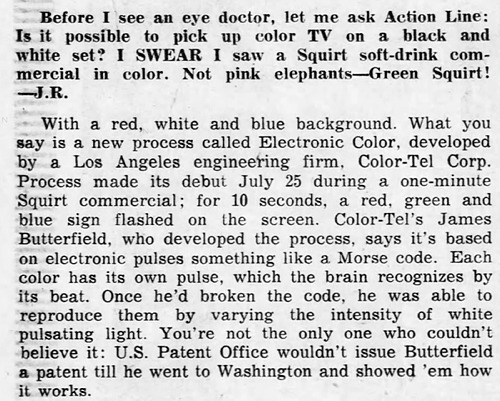
Detroit Free Press - Sep 14, 1967
The technology had some limitations. It could only be used for still images. Also, the colors were muted and flickered a lot. But the really big problem was that the technology emerged just as color TVs were becoming popular. So it was a clever gimmick that no longer had much practical purpose.
More info: Chronicles from the Analog Age Blog
Also worth noting: the idea of being able to see color images on a black-and-white set was the premise of a famous April Fool's Day hoax that occurred in 1962 in Sweden.
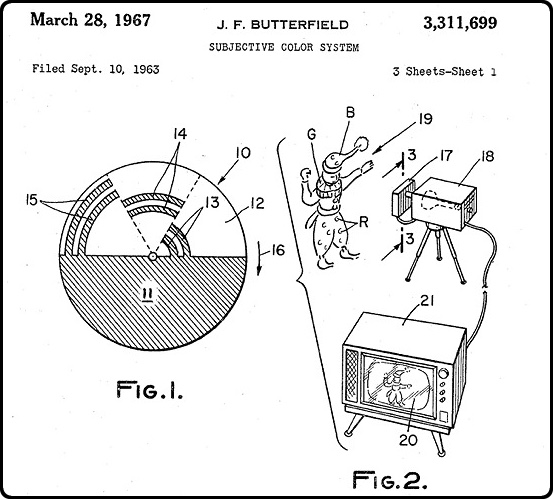
Posted By: Alex - Sun Sep 20, 2020 -
Comments (0)
Category: Inventions, Patents, Television, 1960s

| Who We Are |
|---|
| Alex Boese Alex is the creator and curator of the Museum of Hoaxes. He's also the author of various weird, non-fiction, science-themed books such as Elephants on Acid and Psychedelic Apes. Paul Di Filippo Paul has been paid to put weird ideas into fictional form for over thirty years, in his career as a noted science fiction writer. He has recently begun blogging on many curious topics with three fellow writers at The Inferior 4+1. Contact Us |




